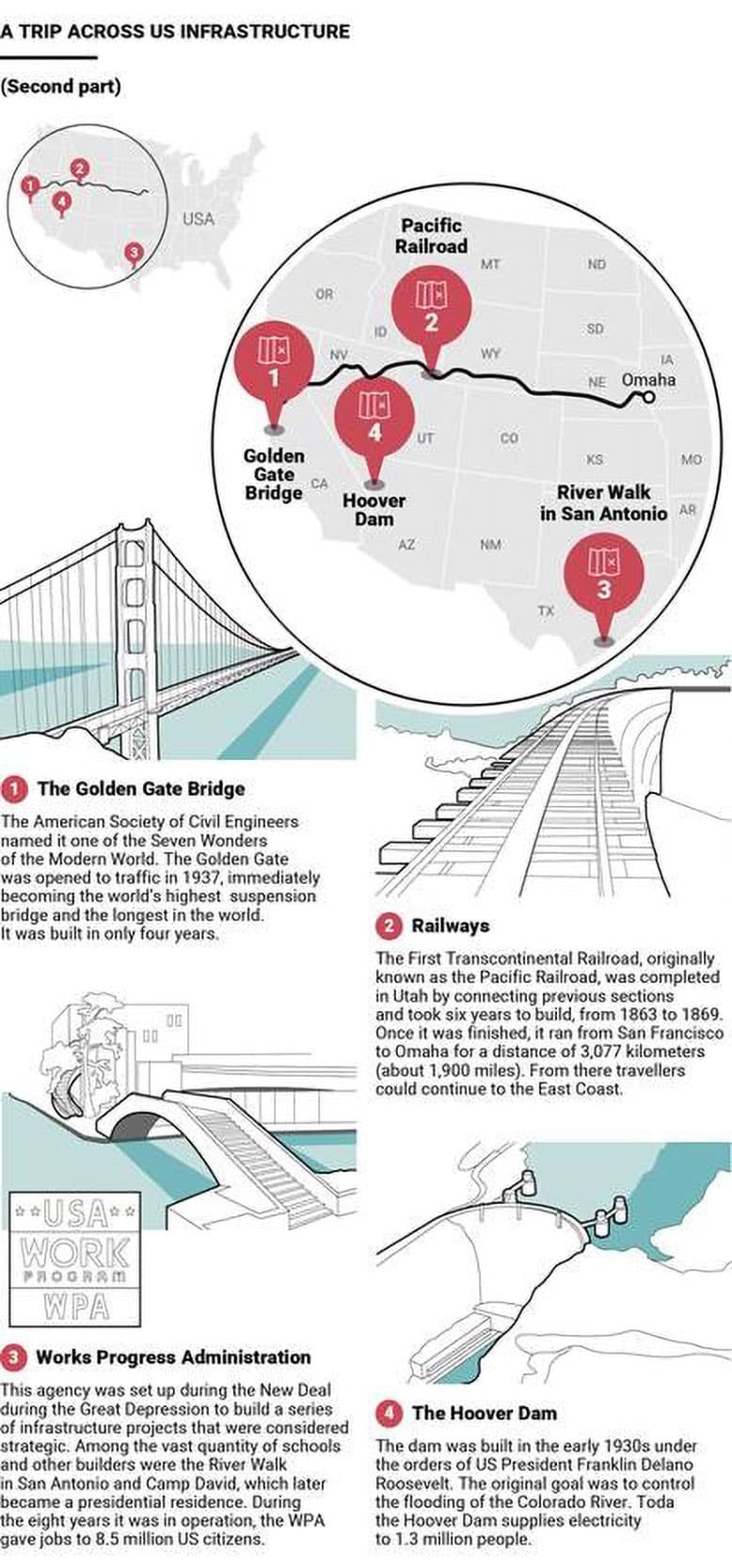
The second part of We Build Value’s trip through America’s most iconic public works heads across the country to the West Coast. We will look at massive projects like the First Transcontinental Railroad, the Hoover Dam and San Francisco’s Golden Gate Bridge, which were fundamental to the country’s economic development.
This history is even more important today, a time when ageing infrastructure is forcing the United States to hold a debate about how and where to prioritise billions of dollars of investment needed to face future challenges like global warming and demographic growth.
The “iron horse” that conquered the West
The invention of the railroad in the 1800s – dubbed the “iron horse” for its revolutionary impact – was at the heart of the young county’s growth, and was fundamental to the conquest of the Wild West. The story of the birth of this momentous era begins at a little-known place near Salt Lake City called Promontory Summit. At the foot of the mountains of the same name in the state of Utah is where the First Transcontinental Railroad was born. Called the Pacific Railroad at the time, it was built between 1863 and 1869. It connected the existing eastern route, which reached as far as Omaha, Nebraska, with Oakland, California. The Pacific Railroad was built by three private companies, using pubic land and a mix of government and private funding. In the end, when railroad magnate and former California Governor Leland Stanford drove the last nail into the track with a silver hammer at Promontory Summit, this coast-to-coast route of 3,077 kilometres was up and running. It radically and permanently transformed the economy and the demographics of the American West. In our own era, new major rail projects – like high-speed ones — are struggling to gain traction in the modern West of cars and airplanes. But they are on the agenda, from Texas to California.
The Hoover Dam
Some of the states mentioned above owe their prosperity to another colossal, timeless work of infrastructure. Between Nevada and Arizona, along the old frontier of the Wild West marked by deserts and large rock formations, stands the Hoover Dam. It is rightfully considered one of the jewels of U.S. infrastructure, built on the Black Canyon of the Colorado River in the first half of the 1930s by the order of President Franklin Delano Roosevelt and funded by his New Deal. The river slices through the country for more than 2,000 kilometres and has nourished the fertile land and life in the region, from the days of indigenous tribes such as the Navajo to the pioneers and gold prospectors who followed. The dam was created to control the traditional flooding of caused by the great river, and it still provides electricity to 1.3 million people. The Hoover Dam remains a strategic work: so much so that it is scheduled for significant renovation to make it more efficient in the production and conservation of energy for the 21st Century.

Camp David, River Walk and the WPA
Visitors to San Antonio, Texas can see one of the most enduring products of the Works Progress Administration, the heart Roosevelt’s New Deal, designed to get America working again during the Depression by building a myriad of infrastructure projects and documenting them through art and photography. Any list would still be incomplete: in eight years and with an initial budget of $5 billion (equal to 6.7% of GDP in 1935), the WPA mobilized 8.5 million people (from 1935-1943) to erect 40,000 buildings including 6,000 schools, 2,550 hospitals, 1,000 libraries, as many airports and tunnels, 500 water and sewage treatment plants, thousands of playgrounds and swimming pools, and as many viaducts. Roosevelt paved a million miles of roads and as many sidewalks. Among the most iconic WPA works are the likes of Camp David in Maryland, which would become a presidential residence, and the San Antonio River Walk: a network of canals designed for the city centre between 1939 and 1941 and dense with dams and bridges, flanked by pedestrian crossings and thousands of trees. It is still one of the main local attractions together with the Alamo, the former Franciscan mission occupied and defended by historical figures such as Davy Crockett, a symbol of the 1935 Texas War of Independence from Mexico.
The Golden Gate
Our journey continues west to California, the promised land for so many American migrations, to San Francisco and its Golden Gate Bridge. The bridge takes its name from its suspension arch that crosses Golden Gate straight and connects the city’s bay to the Pacific Ocean. Its size and graceful shape make it among the best known and photographed images of the entire country, like the Brooklyn Bridge. It is still included among the “wonders” of the world by the American Society of Civil Engineers. When it opened to traffic in 1937, it had the distinction of being the tallest and longest suspension bridge on the planet, with its longest span measuring 1,280 meters rising 227 meters from the water’s surface. The original idea of substituting the ferry service with a bridge belongs to a student, James Wilkins, as early as 1916, but the estimated costs of $100 million at the time (which would be $2.3 billion today) was too prohibitive. In the end it was built for only $35 million and in four years, a record time.

